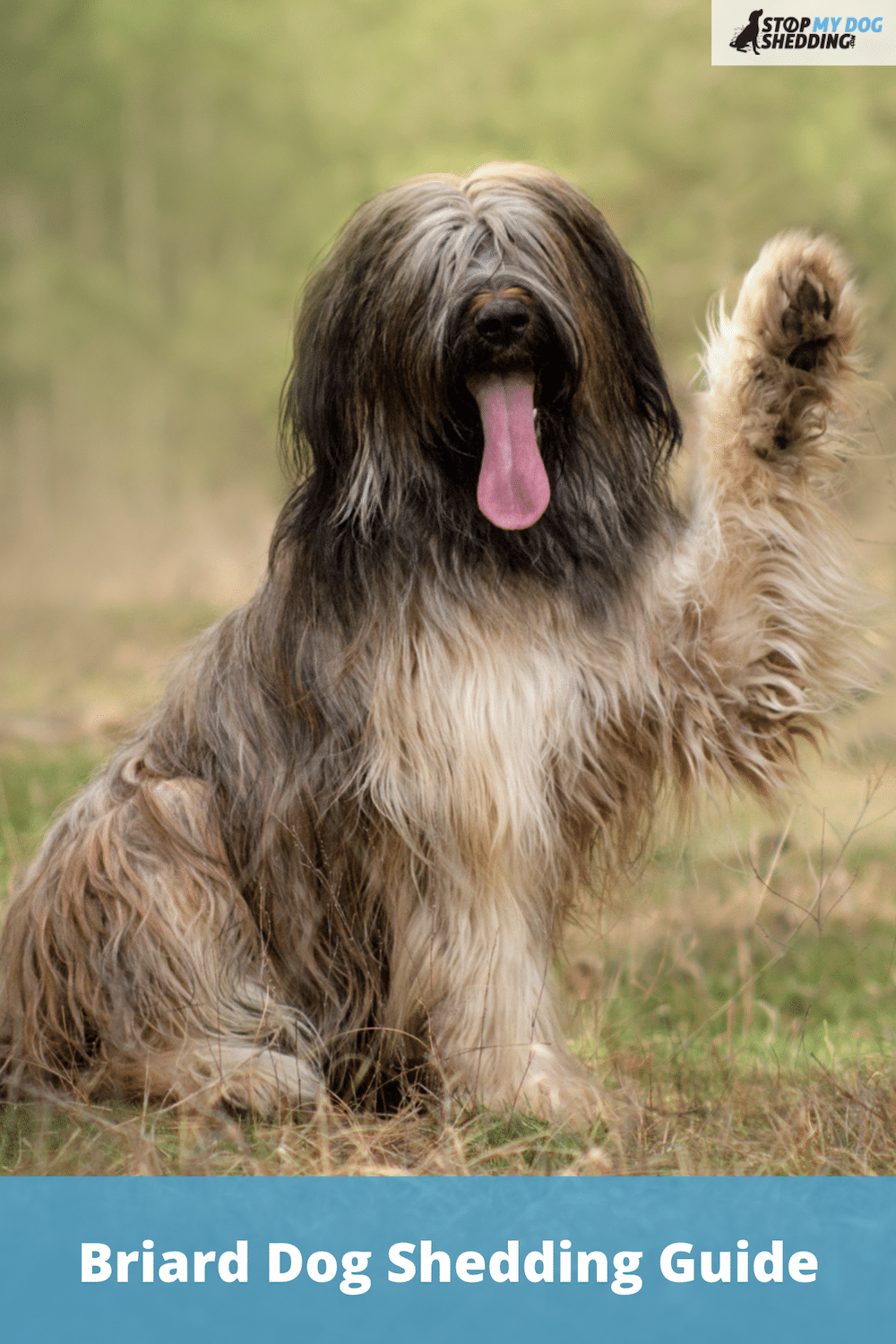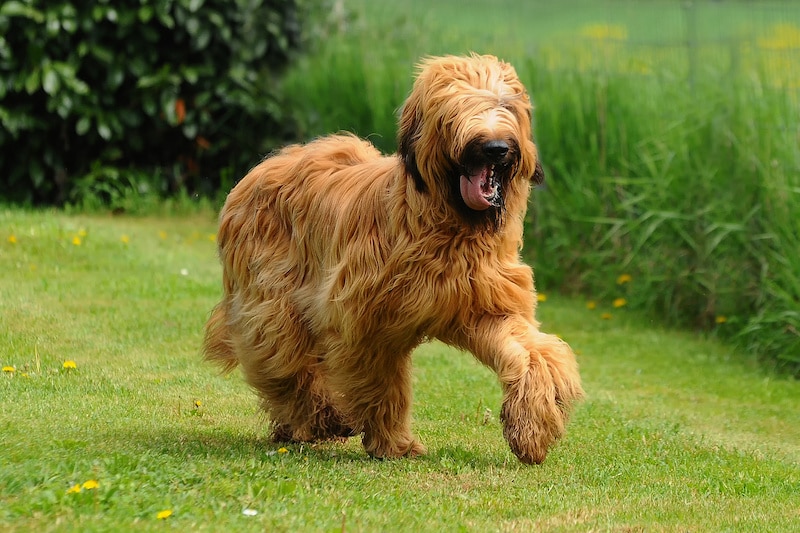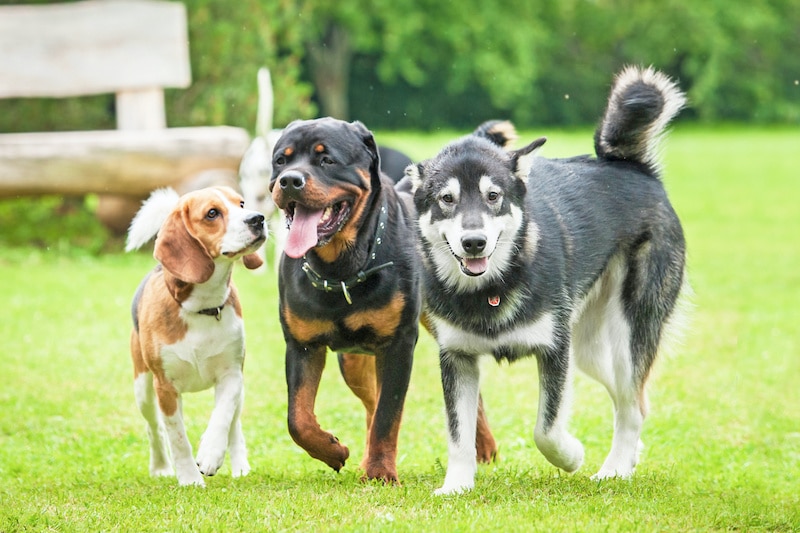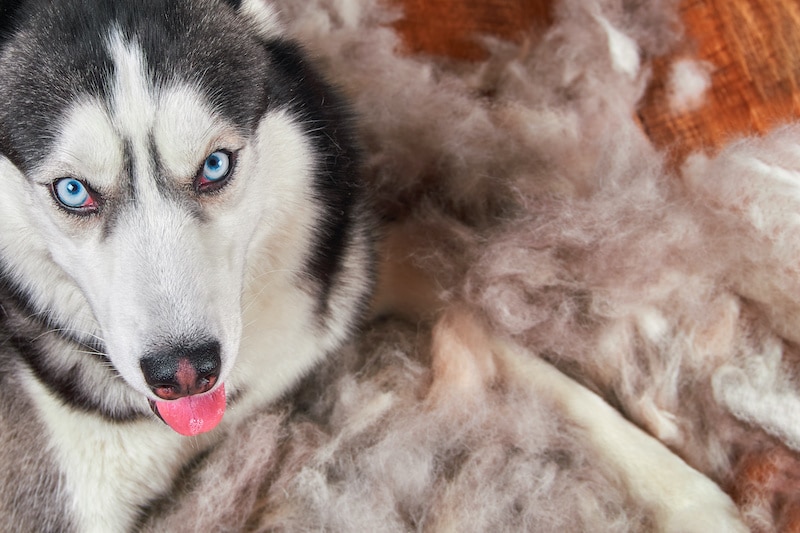The Briard Dog, nicknamed the Berger de Brie, is a large Shepherd breed that hails from France. The dog’s shaggy coat could be enamoring to you, but you may be concerned that that coat will shed a lot.
Are Briard Dogs heavy shedders? The Briard Dog is a very low-shedding breed despite its size and double coat. However, the time you save in cleaning up loose dog fur will probably be taken up with grooming as the Briard’s shaggy coat is prone to tangling and knotting.
This guide to Briard Dog shedding and care will tell you everything you need to know. I’ll even discuss whether this breed is hypoallergenic which may interest those with allergies.
Recommended: Go here to see our top-rated dog hair blow dryers
Briard Dog Shedding
If you’re searching for a low-shedding dog breed, the Briard Dog could be exactly the pup you’ve been looking for.
This large dog sheds minimally; so minimally, in fact, that the Briard has even been called non-shedding.
Now, of course, all dogs shed a little, and that’s true of this breed as well. Yet you won’t have to run around your house chasing after fur with a vacuum cleaner all the time, and that’s an excellent feeling.
What makes the Briard Dog so low-shedding, you ask?
Ultimately, how much a dog sheds depends on the breed. However, there are other factors that can contribute to shedding such as the breed’s coat texture. The Briard features coarsely textured fur, and wiry or coarse fur does not shed as much as other fur textures.
On top of that, the Briard Dog has long fur. Its outer coat can reach lengths of about six inches on average.
If you’ve read other posts on the blog, then you may recall that a dog’s fur grows in four stages. And there are pauses between one stage and another. So if the hair growth cycle takes longer, then you will likely notice less shedding overall.
You can compare that to a short-coated dog. A breed like that goes through all stages of fur growth much faster than a longer-haired canine. So that’s why shorter-haired breeds can shed more. But as I just mentioned, it really depends on the individual breed.
Dogs with short and long hair can both be heavy shedders.
I should also note that the Briard Dog is double-coated. His underlayer is short, fine, and soft. And double-coated breeds will shed with the seasons. This will likely be the case for the Briard Dog as well, so it’s not a bad idea to be ready for some hair clean-up at least twice per year.
The two times of the year your Briard Dog will blow its coat are in the winter and the summer. Seasonal shedding can last for weeks at a time.
What’s remarkable to me is that the Briard Dog is such a big canine (males can reach heights of 27 inches!) and yet sheds so little. This breed is in a rare class with the Irish Water Spaniel and the Afghan Hound. What’s more, Briards aren’t heavy droolers, either.
Recommended: Go here to see our top-rated dog hair blow dryers
Grooming Your Briard Dog
The Briard Dog may not shed much, but its shaggy, wiry coat does require regular maintenance.
The American Kennel Club recommends you “begin grooming your Briard puppy long before he really needs grooming.” This is excellent advice, I’d say.
By grooming early, you can ensure that your Briard is very used to being brushed and bathed. When your dog grows up and the above grooming activities are a regular part of its life, you won’t have to struggle with your pet every time.
I’d recommend a bristle brush for your Briard Dog’s long double coat.
This breed can develop painful knots and tangles, so you should not skip a brushing session.
Brush your dog’s fur at least two or three times a week during non-seasonal shedding periods. When your Briard begins shedding seasonally, you might want to increase its rate of brushing to every day or every other day.
When you brush your dog, you transfer skin oils across your Briard Dog’s body. This moisturizes their skin so it doesn’t dry out and become itchy. An itchy dog is a scratchy dog, after all, and scratchy dogs shed more.
Further, you’ll pull out dead fur before it can fall off your Briard’s body, so brushing is very beneficial.
The way you brush a Briard Dog matters. Stand your dog up on a flat, level surface and begin brushing their feet first. The fur around the feet is especially likely to get tangled.
Divide the fur into sections using your hands and comb through one section at a time. When you find a knot, don’t comb it. Instead, position your fingers so they’re nearer the outer part of the knot. Then work your way to the skin, loosening the knot as you go.
A wide-toothed comb can work through any remaining tangles after you use your hands. Position the comb so it’s nearer the knot’s edge, not against your Briard Dog’s skin. That can be very painful if you begin pulling on the knot that way!
As you work your way up the legs with your brush, continue on the sides of your dog’s body and then the front of the dog to the back. Don’t forget to brush underneath your dog too. You might want to lay them down on their sides for this.
Briard Dogs are generally unagreeable when you try to get a comb too close to their heads. However, knots form around the dog’s mouth and beard, so you can’t forego grooming here.
You can use some dog-safe shampoo and water on the beard to try to dislodge food particles. Then you can brush the face.
Here’s a YouTube video I found that shows you how to section and comb a Briard Dog’s coat:
Of course, brushing is not the only facet of this dog’s care. You may also have to bathe your Briard. Some Briard owners are very much against bathing this breed. It could be because the dog’s fur often poofs out after a bath.
While it’s up to you, I’d advocate for occasionally bathing the Briard Dog. If your dog is visibly dirty or stinks to high heaven, then it’s a good time for a bath.
Use dog shampoo, even sensitive dog shampoo if you can find it (see our top dog shampoo picks). Dilute the shampoo using warm water and then suds up your Briard Dog.
Avoid lathering the fur by rubbing it. I know this is common when washing your own hair in the shower or bath, but it can tangle the Briard Dog’s coat. Rather, let the shampoo soak into the coat without rubbing it in.
Then, rinse for as long as you must until all the soap residue is gone. Please, do not towel-dry the Briard Dog. This breed’s coat is fast-drying, so allow it to air-dry.
If you must use a towel, then blot excess water by squeezing, but do not ruffle the coat.
Are Briard Dogs Hypoallergenic?
If being around dogs makes you itchy and sneezy, or if that’s the case for another member of your family, you might prefer a hypoallergenic dog.
How hypoallergenic, if at all, is the Briard Dog?
Well, allow me to clear up an inconsistency first. Most people assume that a pet allergy is caused by animal fur. What really causes symptoms is dander, which is dead skin.
The connection between fur and skin is that the sloughed dead skin can exit a dog’s body at the same time as shed fur. The fur floats, the dander travels, and you could end up congested and miserable.
Bearing all that in mind, no dog is hypoallergenic if your definition is a dog that causes zero allergy symptoms.
Smaller breeds usually reduce the number of allergy attacks you may have if you suffer from a pet dander allergy.
The reason? A small dog has less skin to shed due to its size.
Small and low-shedding dogs are about as hypoallergenic as you can get. They lose fur less often, which means they shed less dander too.
That brings us back to the Briard Dog.
Although the Briard is undeniably low-shedding, this is one large canine. It has so much surface area that it will lose dander frequently.
Plus, when seasonal shedding spikes arrive, its rate of shed fur and dander can make for an especially challenging time for allergy sufferers.
Not to mention, the dander could be spread more if you’re brushing often, which can be necessary given the breed’s coat requires more attention than most.
So, generally speaking, I would not recommend a Briard Dog if you or anyone you live with has a pet dander allergy. There are other, more suitable breeds if you’re concerned about allergies.
Is a Briard Dog Right for You?
The Briard Dog is a French-bred large dog that would herd and even defend sheep. Known as the Berger de Brie, that nickname is due to where the dog originated, which is a district called Brie. By 1863, the Briard Dog was featured in a dog show in Paris.
A faithful companion who’s undeniably intelligent and confident, the Briard has a vigilant temperament. The breed is playful, adaptable, and somewhat reserved.
I wouldn’t say the Briard Dog is a good candidate for apartment-dwellers looking for a canine companion. This dog is huge in adulthood, and an apartment would feel too constricting. Even a small house or condo wouldn’t suit this sizable canine.
The Briard does best in an environment where he can run and play. Briards are energetic (although not too high-energy) and love to please, so they enjoy training as well. They also do best with an activity or job, which harkens back to their herding days.
Is the Briard dog-friendly? He can be, especially if he grows up around other canines and is socialized with them.
That said, smaller pets are not as good of a match. Remember, the Briard Dog is a herding canine, so those instincts can come out around smaller animals.
With a protective nature, the Briard Dog will keep a close watch over your kids. Sometimes it can be too close of a watch. This breed has been known to jump to a child’s defense when a parent is reprimanding them.
Your Briard Dog will usually bark to alert you of what the dog perceives as danger. The dog can raise its pitch to convey emotion.
Other reasons besides protection that a Briard Dog may bark include separation anxiety, as a greeting, to get attention, out of boredom, or to express fear.
Recommended: Go here to see our top-rated dog hair blow dryers
Bottom Line
The Briard Dog is a huge herding canine from France with a scruffy, rough double coat. The breed sheds minimally despite its size, but seasonal shedding does occur.
Plus, due to the style of coat the Briard Dog possesses, you will have to commit a lot of time to brush and remove knots by hand.
For your efforts, the Briard Dog is a sweet, bright, companionable canine who’s a friend of human and dog family members alike!













Please note: By submitting a comment using the above comment form, you confirm that you agree with the storage and handling of your data by this site as detailed in our Privacy Policy.